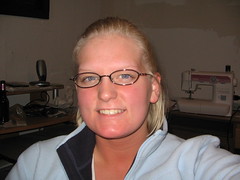To write a daily blog∞ entry about an article appearing in the print version of the New York Times, 4 to 5 times a week. The entries would be opinionated commentary about forementioned articles. I would try for 500 word entries and use several links throughout each post to give the reader more information. I hoped to get a lot of comments, seeing as I was sharing my opinion with the world.
What I Did:
I started out gung-ho, posting everyday. It was really nice to be able to do part of my homework (reading the Times) away from my computer for once. I developed a formula for posting:
Writer
Publisher
Date
Link to online version
Pages in newspaper
One to two sentence summary
Block qoute of text to begin my commentary.
By spring break I began to be burned out on this "formula" as well as creating several links per entry. Often I would complete an entry except for the links, and go back and add them later before I clicked "publish". Finding material was easy, there was normally SOMETHING in the Times that I could rant about for at least two hundred words...
My early postings were long, but also contained a lot of blockquotes. After break I stopped using blockquotes and links so much, only putting them in where I thought them necessary, ie, to prove my point. I started with a goal of about 500 words, which looks really long in a blog. Most people would be scared to read that, even if it was mostly block quotes from another article. I became more concerned about getting my thoughts out than how many words I was actually writing. If I completed my point in 100 words, great, on the same hand, it could take 1000 to get out what I'm trying to say on another topic.
I stopped using the print version of the paper sometime after break, as well. It became a little bit of a hassel to make it to the bookstore everyday, and how many people online would actually go and get their paper to read the article, rather than clicking the link I provided? Even if I did happen to get my paper and read the article that way, I didn't provide the page numbers. Once or twice before I stopped putting the page numbers up I found the article online, and then searched for it in the print edition later.
I also didn't always use the New York Times. I commented about two articles from Glamour, and one day about the recent anorexic/obesity epidemic (which I'm strangely drawn to) after seeing Rachel Ray do a whole show about it, as well as on other tv shows and in magazines. One of my posts was just a repost of a brownie recipie from the Times that was in the top 10 emailed articles for almost a week.
I was hoping to get a lot of comments, which often happens when you put your opinion out there, I got one∞, about the second Glamour I posted. It was a positive comment, and was really nice to know that someone out there was reading, and liked what I was saying.
I thought I would end up following developing stories more, but I found that in a few cases, such as the Imus story, I didn't want to comment on anything until a) I knew as much as I could and b) things had dwindled down. With the Imus story, I really didn't know who he was, so my post about that is mostly a chopped up biography from his wikipedia page. There was a ton of coverage of this story, in the Times and beyond, but I find that I get burned out on a story that gets too much coverage, like the Anna Nicole saga.
Often I would find my articles and start my post, but finnish either later that day, or on a day that week I had more time (like the weekend). My articles weren't always from the same day as the post.
Why I Chose a Blog:
Wikis don't speak to me the same way a blog does. Maybe it's because the format of a blog is similar to a magazine column. Even Cosmo has a regular feature published in their print edition entitled "bedroom blog." Before this class I hadn't kept a very regular blog. I had one attached to my msn livespace as well as my myspace page, but my posting was sporadic at best. Like many people, I never thought of blogs as serious writing medium, at least not for the average person. I had heard of more serious blogs such as the Huffington Post, but I never realized how mainstream they are, especially in journalism. It seems that almost any "reporter" who works at a tv station or newspaper these days has a blog hosted by their employer.
The Look:
I chose the layout for my blog∞ (just from the pre-set templates Blogger had) because I thought the colors were professional, but creative. I did do a little tweeking here and there, like changing the color of the text and the links. I liked having my blog on the right, so that's the first thing people see as they see my page. I had my blogroll and what not on the left, for further exploration. I used my blogroll to promote other news blogs, including Emily's NYT blog. I also created a section titled "interesting links I stubble across" which was two links to pages with people's expressing what I find to be very radical personal opinions.
What I Learned:
- It's hard to post every day.
- No matter how much you like something, you can become burnt out on it.
- It's a good feeling to get comments.
- It's an even better feeling to get positive comments.
- Even if you don't get comments, it doesn't mean that no one is reading.
- Senioritis does not help work ethic at all.
- Neither does nice weather.
- Using the New York Times as inspiration
- Posting at least 4 times a week
- Long posts, they just weren't practical
- Posting every week day.
- There's always gonna be a day here or there where spending an hour by the computer just won't happen.
My drive. My project proposal had plenty of room for flexibility, but when it came to posting regularly, especially near the end, it was hard to get myself motivated. There was always something else I could have been doing, whether it was legitamate homework, playing silly games, or watching bad TV. But, I did grab my laptop and post while watching said bad TV a lot.
Reflection
The internet is changing journalism, even as we speak. Blogs are major player in this change. It was bloggers that dethroned Dan Rather∞from his top news anchor position in 2004. "New media" has become a way of life. With a computer and an internet connection, you can read the day's news and watch your favorite TV show. (Some networks stream their tv shows, others can be dowloaded from programs like iTunes.) "New media" rolls television, radio and print into one neat little package, all for about $30/month, plus download fees.


